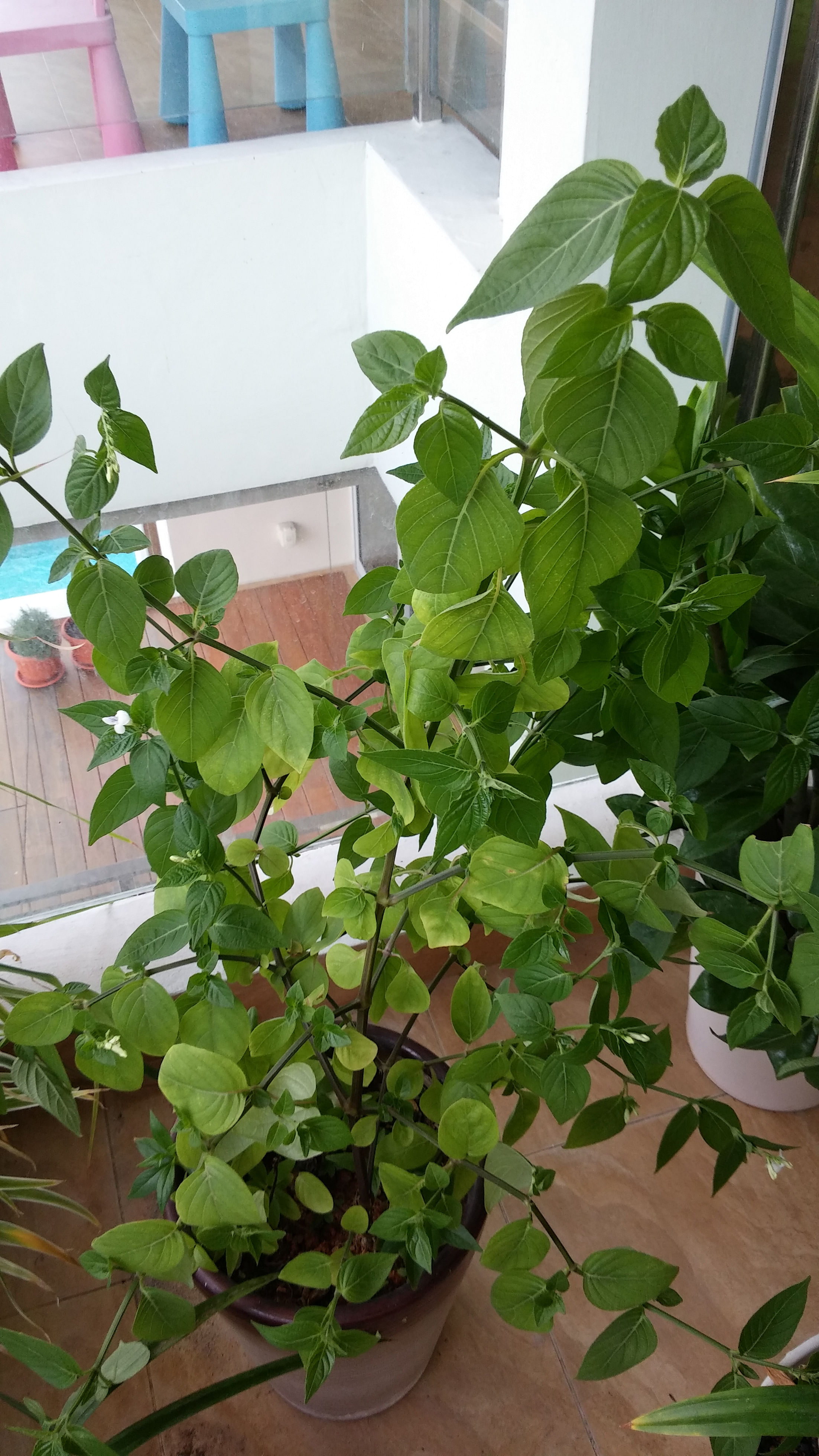Laurel Clock Vine needs water and nutrients
I have a Sky Vine that does not grow well under full sunlight. The leaves tend to turn yellow, while its edges turn brown. They also drop off easily. Does the plant lack nutrients?
Jeremy Seah
The plant is Thunbergia laurifolia and its common name is Laurel Clock Vine.
The symptoms appear to be mainly due to the lack of water and nutrients.
Did you grow the plant in a container? The plant's roots could have filled the container.
Under direct sunlight, the plant suffers from heat and water stress which leads to the appearance of yellowing leaves and sparse overall foliage cover.

Once roots have filled the pot, there is very little soil volume to hold water for the plant and the supply of nutrients could have also been exhausted. The lack of nutrients can be seen as chlorotic leaves appear in the picture.
You may want to move the plant to a larger pot.
Alternatively, take the plant out from its existing container, shave away the roots around the rootball by about 1cm. Use a sharp knife and repot the plant in fresh soil.
At the same time, install automated irrigation to ensure your plant is given water and its root zone is kept moist.
Liquid fertiliser can be added to the water to feed your plant.
Tip: Variegated Jewels of Opar has edible leaves
The Jewels of Opar is a medicinal plant that is sometimes grown in local community gardens.
It is not to be confused with another similar-looking and related species called Surinam Purslane, which is known as the "Earth Ginseng" locally or by its botanical name, Talinum triangulare.
As pictured above, the Variegated Jewels of Opar (its botanical name is Talinum paniculatum "Limon") is a new introduction with bright yellow, variegated leaves that are highly ornamental.
Like its non-variegated version, the leaves of this plant are succulent and produce branched flower sprays with small pink star-shaped blooms, followed by round fruits.
The leaves are edible and can be added to salads or lightly stir-fried or boiled.
This plant should be grown in a well-drained location as it is susceptible to rot in overly wet soil. However, it should be kept moist and not allowed to dry out completely.
Under local conditions, it does best in a semi-shaded location and can be propagated easily via stem-cuttings.
Money plant infested with mealy bugs
I keep a pot of money plant in the office. It is placed next to a window where it gets the afternoon sun. It has been growing well, though the leaves develop brown tips when I overwater it. In recent months, the plant has white spots, which are almost everywhere. I removed the white spots with a wet tissue, but they came back. What should I do?
Elizabeth Hew
The pests affecting your plant are likely mealy bugs. They are sucking pests that often appear if plants are stressed due to sub-optimal growing conditions.
Although the money plant is a shade-tolerant plant, it is best to grow it in a location - such as a windowsill or balcony - where it can be exposed to at least four hours of filtered sunlight.
You can take the plant for a "suntan" periodically especially if it is used for display elsewhere.
To manage the population of mealy bugs, use environment- friendly methods such as spraying the plant with neem oil or summer oil. These oils work by covering the pests and suffocating them.
Remember to spray all parts of the plant, including both sides of the leaves and the tight spaces between young developing leaves and shoots which aphids tend to feed on.
Avoid spraying the oils during the hottest time of the day.
You can also use a strong water jet and wash the pests off.
Ease plants gradually into new growing spot

I have recently acquired a yellow palm and jasmine plant, both potted. They are placed on the patio, under shelter and get oblique morning sun. Within a week, I noticed that the leaves of both plants turned yellow while they appeared green and verdant before. After some research, I suspect this happened because of a lack of nitrogen and overwatering. I added some fertiliser and am watering them now every alternate day. Is this the right thing to do?
D. Lai
You may be right on the diagnosis.
For the lack of nitrogen, applying a water-soluble fertiliser should quickly remedy the situation.
To tell if your plant has been overwatered depends on the environmental conditions that your garden offers and the pot size and soil type that the plant is grown in.
To check, stick a disposable chopstick into the soil and pull it out. The soil is moist when there are some soil particles sticking to the chopstick and traces of water. Note that plants should never be allowed to dry out totally.
Do you know if the plants were grown under shadier conditions previously? A sudden change in light intensity exposure can cause the leaves of plants to turn a bit yellow.
If this was the case, your plants may require more time to adapt to the light conditions in your home garden. This needs to be a gradual process.
It is also important to ensure that the plants are not pot-bound, where the roots fully fill the pot. Such a situation will restrict the amount of water the plant needs for healthy growth. In addition, during hot weather, plants can experience water stress and leaves can turn yellow.
Chinese Violet food for butterflies

What is this plant? It has small white flowers.
Ronnie Wong
It is likely the Chinese Violet. Its botanical name is Asystasia gangetica ssp. micrantha and is a member of the Acanthaceae. It is a common weed that grows in the open and semi-shaded areas outdoors.
It has small, white flowers with a purple-tinted lip. The leaves are food for the larvae of several local butterflies which include Autumn Leaf, Great Eggfly, Blue Pansy and Jacintha Eggfly.
- Answers by Dr Wilson Wong, a certified practising horticulturist and founder of Green Culture Singapore (www.green culturesg.com). He is also an NParks-certified park manager.
- Have a gardening query? E-mail it with clear, high-resolution pictures of at least 1MB, if any, and your full name to stlife@sph.com.sg



